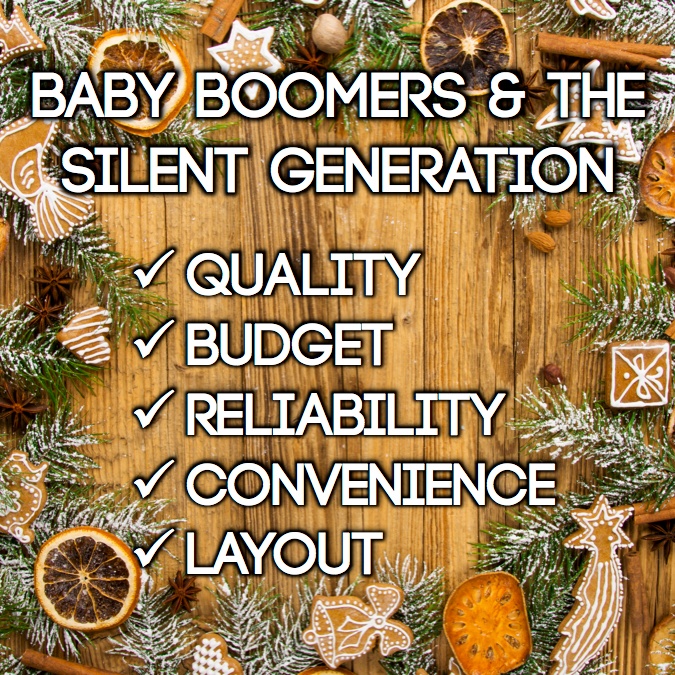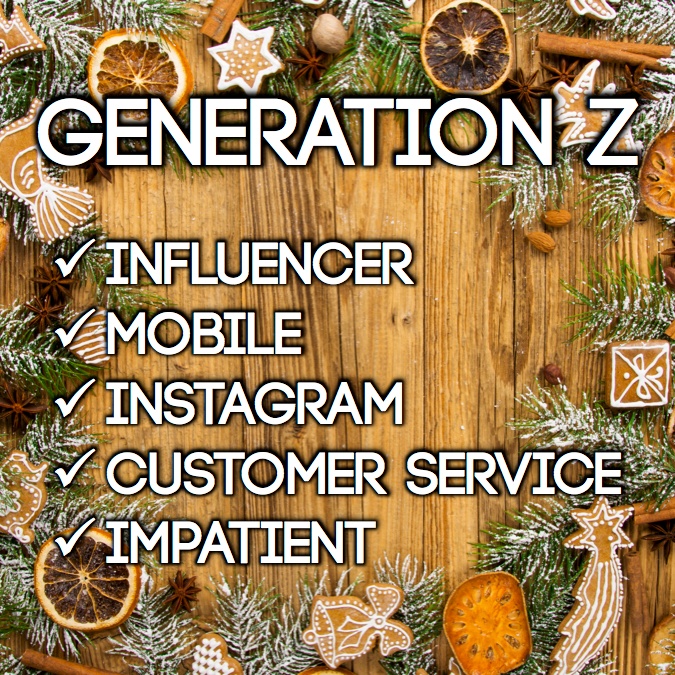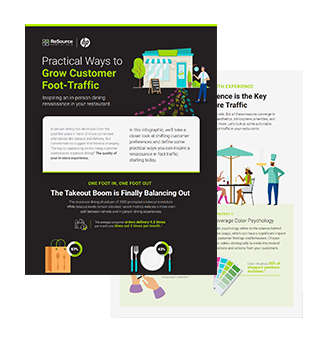Who are your customers? Are you reaching their expectations this holiday season?
It may seem obvious that in order to make a potential sale, you need to really know your customer. As a retailer, it is essential to hone in on your target consumers to ensure your business brings them their ideal experience that will keep them coming back to your store even after the holidays. Read on to discover how generations’ buying behaviors vary and what your business can do to cater to their expectations.
Millennials (aka Generation Y):
There are 83.1 million Millennials (18-34) in the US which are estimated to reach an annual spend of $1.4 trillion by 2020, about 30% of total sales. Although this generation is riddled with debt, they still hold plenty of purchasing power.
It may be surprising, but 82% of Millennials actually prefer brick-and-mortar stores when shopping. That being said, they have some high expectations including fast checkout times, personalized promotions, superior customer service and of course, expect seamless cross-channel experiences.

In fact, 75% of Millennials aged 25-34 are more likely to shop at a retailer if in-store technology is available. Over half of Millennial shoppers use a smartphone in-store to search for discounts and coupons and a whopping 84% of Millennials use a smartphone while shopping to answer any questions they may have about products or the brand.
A very unique characteristic of Millennials is their love of experiences over material things; 78% prefer spending their money on experiences such as concerts and parties. They also love sharing these moments over social media as well as through surveys and reviews, which means honest feedback regarding in-store experiences, brands and products.
In terms of influencers, 70% of Millennials are more influenced by non-celebrity bloggers over celebrities and 62% would consider a product recommended by a YouTuber over a TV or movie star. In addition, nearly half of Millennials report wanting to do business with companies that are environmentally conscious or support social causes; a brand’s authenticity and story can be the make or break moment for a new Millennial customer.
How to Earn Their Business:
Consider doing an exclusive event to boost sales and attract Millennials craving a unique experience. Make the most of social media and advertising by aligning your brand and products with bloggers and YouTubers over celebrities. You can combine forces by not only partnering with a blogger to advertise your products, but also create an event where said blogger or YouTuber visits your store to connect with fans and further push your products.
When marketing your brand, discounts and sales, make sure your message is authentic since Millennials are drawn to stores which share their story and value brands which care about causes. Transparency and price matching are also key since Millennials are well informed, connected and seek the best deals.
Baby Boomers & the Silent Generation:
The Silent Generation is made of about 50 million children born between 1925 and 1945 while Baby Boomers were born 1945 to the 1960s. These generations have a greater disposable income and according to government, Moody’s Analytics and Visa data, Americans 55 and older accounted for 41.6% of consumer spending in the first quarter of this year. These older generations comprise about half of all consumption in the US and on average spend more per transaction.
Although many assume older generations spend less time online shopping, Baby Boomers surveyed shopped online just as frequently as the Millennials. In regards to the products they are buying, this generation is more likely to buy healthcare products, wine, household goods and appliances — all categories which tend to have higher price points. Factors influencing a purchase for this generation include product quality, budget, value and reliability.

Baby Boomers top the generations at 84% in saying they prefer shopping in store, but also hold high standards for their overall experience. In a LoyaltyOne survey of US and Canadian consumers, Baby Boomers were the most likely to write off a retailer if a sales associate didn’t appreciate their business, if a store was messy and if returns were a hassle. Shopping is not a relaxing experience for baby boomers so they look to retailers to provide convenience, siting location, store layout and a clear return policy as factors influencing their purchase decisions according to Loyalty One’s survey. In addition only 37% of Baby Boomers browse within a store, which means store layout and informed staff are crucial.
According to a Synchrony Financial report, “Balancing Multi-Generational Retail Strategies,” Baby Boomers also love coupons and sales and 75% are more likely to purchase if they have a coupon or loyalty discount.
How to Earn Their Business:
Remember: convenience and functionality are key.
Baby Boomers and older generations do not necessarily see shopping as a relaxing experience so both website and store design and layout are essential to attracting and keeping costumers. Knowledgable sales associates as well as clear and well organized stores and signage, allow older generations to quickly find and purchase what they want and need.
When marketing to this generation, quality as well as price are the most influential. Although not greatly influenced by family and friends, Boomers are twice as likely as Millennials to be influenced by the popularity of an item.
Generation X:

Generation X, commonly abbreviated to Gen X, is the generation following the Baby Boomers born 1965 to the 1980s. If this is your target demographic, keep in mind that atmosphere, ratings & reviews, availability of tech and fast checkout influence whether they make a purchase or not. Though Xers are often a forgotten generation in retailers’ marketing, they, by far, have the most disposable income and despise marketing which is not personalized to their values and needs.
This generation is unique in that they are very skeptical so they value transparency. Xers are also drawn to smaller, underground brands and the values they espouse which is good news for independent retailers and smaller specialty shops. They are less likely to follow trends and prefer high quality products which are niche and unique. The good news is that Generation X remains very loyal to brands they trust and brands which show them outstanding customer service.
Generation X also spends a lot of time online researching products before going to a physical store and purchasing. They compare prices and values and seek lots of information before making a decision. Unlike Millennials, the best way to reach Xers is through email. Gen X shoppers also look for information via Google rather than social networks.
How to Earn Their Business:
Honesty and transparency are key to this no-fuss generation. Provide a good amount of details on your products online for research purposes — you may even want to compare your pricing or features to other products.
Take advantage of Google AdWords and email marketing since this is what Generation X uses most when researching products before purchase.
Even though Generation X is more discerning, they are loyal so it may be a good idea to adopt an easy-to-use loyalty program, focused on how much money they are saving by choosing your brand.
Last, but certainly not least, focus on your customer service since this is vital to Generation X’s decision in choosing your store over others.
Generation Z (Gen Z, iGen, Centennials):
Generation Z represents those born in 1996 and later meaning the oldest members are graduating college while the youngest are not even in kindergarten. Despite this large age range, one thing all members of Generation Z have in common is that none of them has lived in a world without internet or mobile devices. Although still quite young, it is important to consider that by 2020, today’s 14-19 year olds will be the largest group of consumers worldwide, making up 40% of the US, Europe and BRIC countries, and 10% in the rest of the world according to retail consultant company, Fitch.
Although this generation does not currently have much purchasing power, they are major influencers of family purchases. In fact, 93% of parents say their children influence family spending and household purchases while 70% of Generation Z admits they influence family decisions on purchases such as furniture, household goods and food and beverages.
Generation Z know they are major influencers and considering 44% use Instagram as inspiration for holiday gifts, retailers need to make sure they are using the platform to market their brand and products. In addition, Gen Z is not shy about their purchases and love to connect with their friends over social networks and even compile shopping ‘haul’ videos.

Surprisingly, although this generation is accustomed to having technology at their finger tips a recent global IBM study found 67% of Generation Z shop in brick-and- mortar stores most of the time.
“Mobile is the number one device that they use — they’re connected all the time. They literally have the phone on their fingertips, and that definitely makes them more impatient. They expect things to be there when they need it, but makeup, clothes, shoes — they still want to go to the store to check the product out. And if they try an outfit on, they want to take it home. They want the satisfaction of trying it on, and having it then and there,” explained Jane Cheung, Global Leader for Consumer Products for the IBM Institute for Business Value.
Even though Generation Z enjoy shopping at physical stores, their expectations are far from low. Not only do retailers need to create a personalized, interactive experience featuring digital and mobile innovations, it also needs to consider layout and signage. According to Fitch, Gen Z tends to navigate at eye level and pays more attention to products over any signage. Touch and access to products is key as well as visible price tags.
IBM found over half of those surveyed, 52% said they would transfer loyalty from one brand to another if the brand’s quality is not up to par. Since this generation is accustomed to technology, they are highly impatient and demand responsive customer service. According to data analytics company Marchex, Gen Z is 60% are more likely than the average consumer to hang up if the phone is not answered within 45 seconds.
How to Earn Their Business:
Generation Z responds well to brands who keep messaging short, concise and visual with an option to access more information. They also value transparency as well as innovation in products and in-store experiences so mixing in digital aspects to inform and enhance the shopping experience is imperative.
Highlight your business’ and products’ innovation and improvement, if possible, since Generation Z actively dislikes products that aren’t constantly changing.
Customer service is key online, over the phone, and in-store as this generation has high expectations and no trouble switching to a different brand if they have a bad experience.
Since Gen Z is a big influencer and loves to share, make sure to adapt and make sharing their purchases and experiences across online platforms as seamless as possible. As a retailer, this is an effective way of marketing, with little effort!
Are You Ready?
This holiday season, focus on getting to know your CUSTOMER.
Across the board, it is obvious that all generations expect a seamless experience both in-store and online which means optimizing current technologies and considering the addition of more.
“Companies should be channel agnostic, meaning it does not matter if they start with online or offline, what matters is that all channels are interlinked to give consumers the convenience they need,” Paul Martin of KPMG explained. “Online plays a major part in the customer journey or ROPO (research online, purchase offline). The most successful multi-channel companies established their online channels as early as the late nineties, went on to establish ‘click and collect’, eradicated silos across the entire organization and established a channel agnostic incentive program so retail staff do not consider online as a separate business.”
It is essential to design your online and physical presence to create a frictionless and pleasant experience to consumers. In this day and age, that means blending digital and in-store experiences to guide shoppers throughout the holiday season. For example, Lord & Taylor and Saks have increased digital presence to spark in-store conversions through personalized recommendations and apps. Starbucks is another great example of a successful omnichannel strategy. They developed a mobile app that allows their users to purchase with their smartphones or to order their coffee ahead and pick up in store without having to queue.
Remember to make the most of your consumers time by using promotions, technologies and strategies to optimize their overall shopping experience. This means having an organized layout, clear signage, attractive displays as well as anticipating inventory and staff needs. Since fast checkout time is a cross-generational must, many stores have already prepared by arming sales associates with tablet devices to not only help in finding particular items, but also to speed up purchasing and reduce wait time. Mobile POS technology is not only important to enhancing the experience in-store, but also to reduce lines and chaos which can deter potential customers from even entering the store.
Think outside of the box and focus on what your demographic wants and expects this holiday season. For example, Hollister reaches young shoppers including Millennials and Generation Z through its Club Cali program which rewards points for downloading the app, linking to social accounts, and completing a member profile. They’re also elevating the member experience through in-store concerts and exclusive gifts.
To increase transparency and trust, retailers are encouraging and embracing price comparisons through their websites and other online platforms. In addition, technology savvy retailers are incorporating QR codes on products and displays in-store so that consumers can easily access the product’s mobile websites for more information. Some stores like Best Buy create buyer guides according to trends and product popularity.
The time to innovate and evolve is now. Keep in mind, the National Retail Federation discovered 77% of shoppers left stores because they couldn’t find what they were looking for at an average of 4 times over the holiday season in 2016 — that translates to 4 missed sales — don’t let this be you!

